#traditional basque clothing
Text

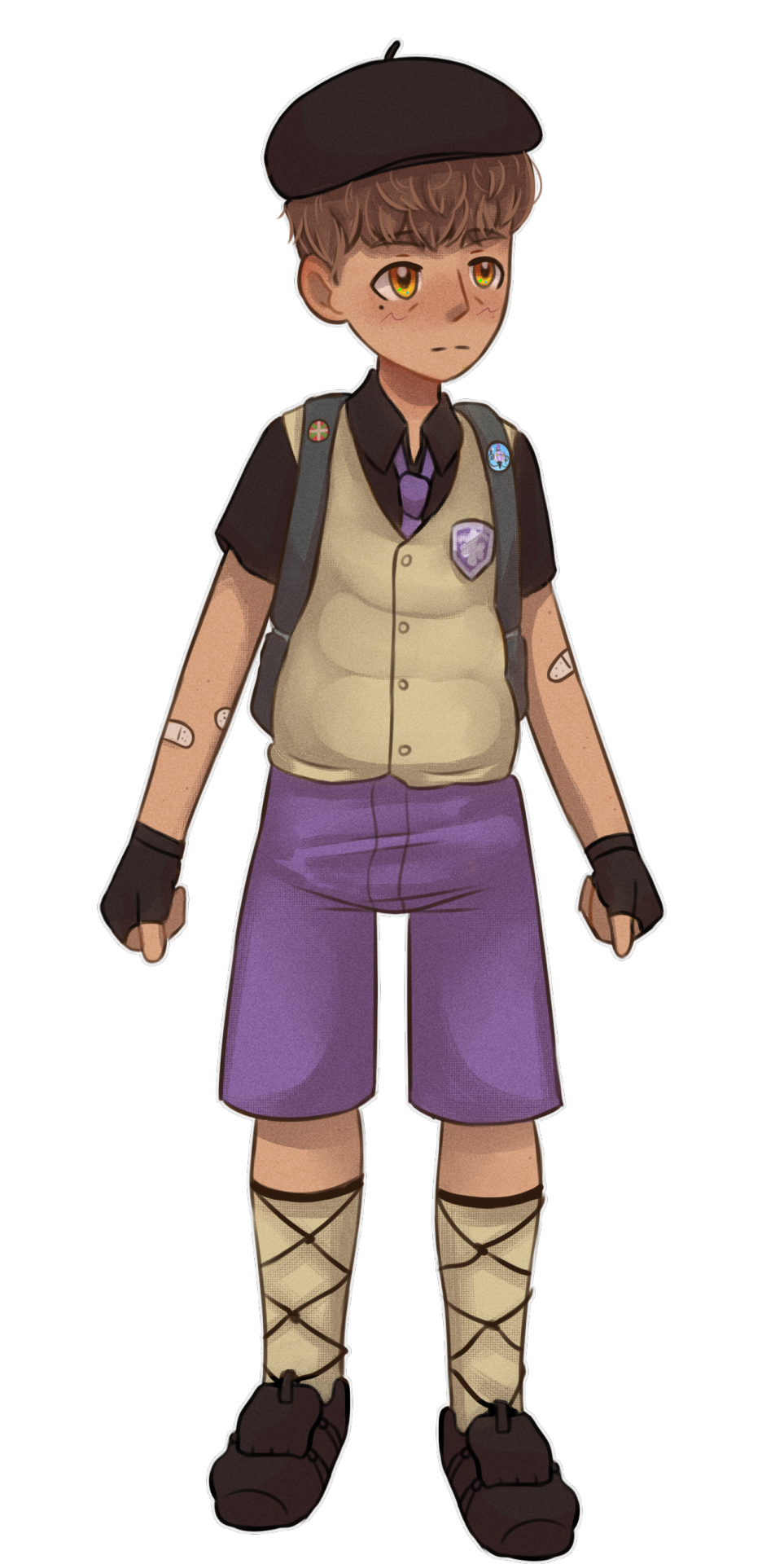
Drew my Pókemon trainer from Violet! They just moved to the south from the northern region :)
References for traditional Basque clothing that inspired the fit:

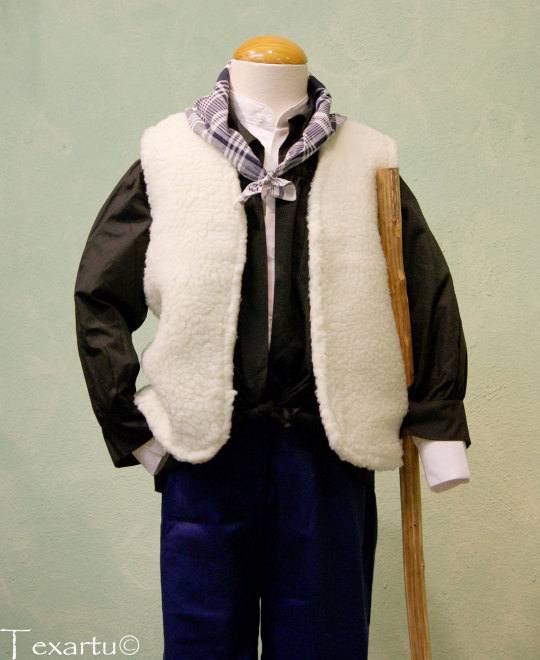
#pokemon violet#gen 9#pokemon scavio#pokemon trainer#pokemon OC#their name i subaru#like my sona#i did my best with the customisation options in-game. the in-game character looks similar to this but i did some tweaks in my design so#that the traditional clothes are well represented#Pokemon Scarlet and violet#pokemon escarlata y púrpura#pokemon purpura#traditional basque clothing#basque country#euskal herria#my art
6 notes
·
View notes
Text

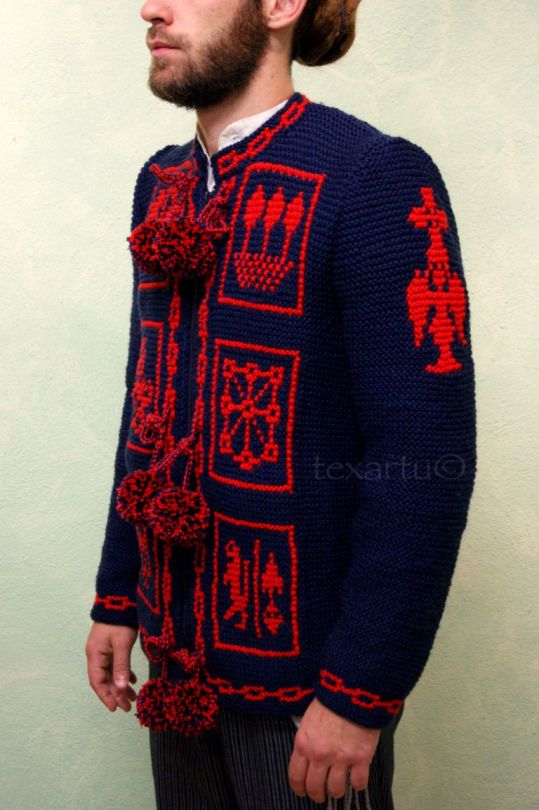
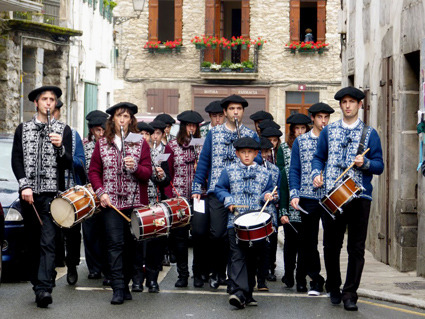


If only mendigoizaleak were more popular to wear as everyday clothes!
Mendigoizale means “mountain enthusiast”. It’s a traditional wool jacket with drawings on the front depicting lauburus or the coats of arms of the seven Basque provinces (Nafarroa and Nafarroa Beherea are represented by the same coat of arms, hence they're just 6). It’s closed with six pompoms.
It seems that they were originally called “draughts jackets” because the front had a draughtboard pattern. But in the early 20th century that pattern was replaced by the coats of arms and Basque symbols by clubs and amateur mountain climbers that were reclaiming traditional clothing as also a symbol of Basque identity; thus the name mendigoizale spread, because it was these mountaineers who were wearing them again.
What do you think? Do you like mendigoizaleak or not?
#euskal herria#basque country#pays basque#pais vasco#euskadi#mendigoizale#traditional clothing#tradition#culture#folklore#basque people
201 notes
·
View notes
Text

Basque dancers, from Spain, by Oinkari
#basque#spain#europe#western europe#folk clothing#traditional clothing#traditional fashion#cultural clothing
214 notes
·
View notes
Text
Please reblog for a bigger sample size!
If you have any fun fact about Basque Country, please tell us and I'll reblog it!
Be respectful in your comments. You can criticize a government without offending its people.
142 notes
·
View notes
Note
holiday outfit for rei?
Ooohh! You know the battlepass really makes me sad because I really miss seasonal skins and it looks like any skins that would be "Winter Wonderland" are probably going to be locked behind bundles (Barf). But I did Winter Wonderland skins for the fankids in the past, it would be a fun challenge to try a couple again!!
Rei: Frost Fairy--Okay I know I say that the snow/ice themes are Blizzard phoning it in, but when both Mercy and Genji have ice skins, it seems only appropriate. Her wings are complex and spiky, reminiscent of hoarfrost. Rei's hair is tinted white and pushed back from her face in a kind of wild shoulder-length mane held back by a silvery headband crest reminiscent of Genji's Ice Wraith helmet, with two icicle horns peeking out underneath. Her clothes incorporate some armor-like elements from Genji's Ice wraith skin, but is probably closer to the Banuk clothing in Horizon Zero Dawn.
Aedan: First Frost--A skin that has both autumnal and winter elements, Aedan's clothes are composed of scarlet autumn leaves outlined in silvery white by frost. Very Thranduil vibes. His red hair has white streaks in it and he wears a twiggy laurel-like crown of leaves also touched by frost. His eyes are tinted golden yellow in this skin. Because ya girl loves her Prince Nuada vibes.
Jaime: Olentzero--Olentzero Jaime wears and black beret and blue neck scarf, as well as traditional black, gray, and blue Basque farmer's clothing smudged with coal dust all over. There's a wineskin at his hip and a pipe in his mouth. There's a slightly ghostly effect on his ability animations.
Marti: Eggnog---A cute confectionary skin that's a lovely cream-color with a cinnamon brown gradient. Marti dons a peacoat shawl dress with wooly trimming to mimic the foam. Marti's hair is tied up in a big bouncy curly blown-out ponytail with cinnamon stick hairstick accessory. She wears white leggings with a cable-knit pattern and cute chunky brown wool-lined boots. There will be some debate as to whether the skin should be called the "eggnog" skin or the "horchata" skin but like--I mean you can drink horchata all year, so we're leaning towards the eggnog skin.
Faustine: C.E.O (Chief Elf Officer)--Faustine dons pointy ears, a high bun secured with a sprig of holly, a pencil behind one ear, and a sexy green pencil skirt and green vest with gold damask texture effects. The dress shirt has a sort of frilly cravat collar decorated with a gold brooch. Comes with a "Checking it twice" emote where she checks a tablet and looks up judgmentally.
#fankid ensemble#that's all i got for now#if i come up with more i'll reblog myself later#follow for more gency kid facts#love that the basque country has a santa claus who's just like... a guy
4 notes
·
View notes
Text
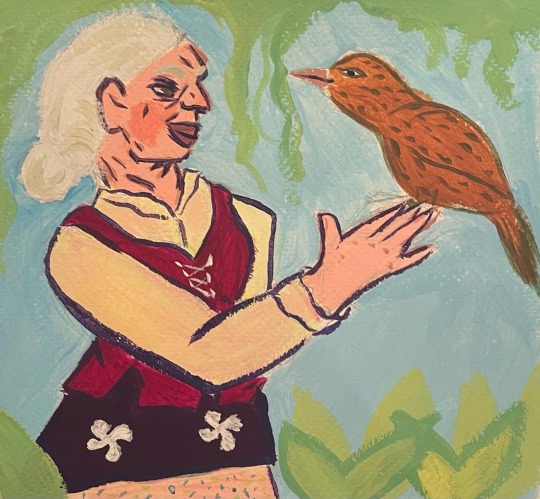
Day seven and final day of charlyclements funwithfaces challenge on instagram! Todays prompt was bird, white hair and garden.
I was also reminded of a Basque song called «Hegoak,» which is about the relationship between the singer and the bird. I found it fitting so I decided to have the person dressed in traditional basque clothing, specifically a casera. I like imagining that this lady and the bird are old friends.
It’s been a fun challenge, but longing for a break now, haha!
3 notes
·
View notes
Text
welcome!
this blog loves planet earth and the people in it.
some notes:
I generally try to identify places + groups
I try to make conscious decisions about tags that respect cultural identities, consider historical context and reject imperialism. I realize this is impossible and messy and doomed to be inconsistent. choices I've made include one Korea, one Ireland, and multiple tags for separatist states, i.e. Scotland, Catalan Countries.
I am currently unsure when or if it makes sense to tag the "bigger" nation in a post about an autonomous region, ex. China and Tibet, Faroe Islands and Denmark. I want to respect widespread independence movements, but also not become bloated with regional tags. Tibet deserves to be free of China but I have to laugh at modern Texas separatism.
Israel does not get a tag. Jewish diaspora, Free Palestine, genocide, USA, and anti imperialism are used.
I am not always sure when to use the indigenous peoples tag. if I am unsure I will probably leave it out.
except the history and prehistory tag, I currently am not tagging things that no longer exist, ex. Soviet Union, Ancient Greece
Some tags like EU, UK, Africa, Asia, Latin American, Polynesian, etc. are used in posts that refer to many places/groups collectively ex. Lunar New Year in Asia
I try to tag the country/group that an artist/writer/creator belongs to, ex. a post featuring Baldwin tagged with USA, literature, black diaspora
tags are ever-evolving
country/place tags:
Africa, Albania, Armenia, Asia, Australia, Austria, Azerbaijan, Belarus, Belgium, Bhutan, Bosnia and Herzegovina, Botswana, Brazil, Bulgaria, Cameroon, Canada, Catalan Countries, Central African Republic, Chad, Chile, China, Colombia, Congo, Cuba, Czechia, Denmark, Dominican Republic, Emirates, Estonia, Ethiopia, EU, Faroe Islands, Finland, France, Germany, Greece, Greenland, Guatemala, Haiti, Hawai'i, Hungary, Iceland, India, Iran, Ireland, Italy, Japan, Kazakhstan, Kenya, Korea, Kosovo, Kyrgyzstan, Latvia, Lithuania, Malaysia, Maldives, Mexico, Moldova, Mongolia, Montenegro, Mozambique, Namibia, New Zealand, Niger, Nigeria, North Macedonia, Norway, Pakistan, free Palestine, Paraguay, Peru, Philippines, Portugal, Qatar, Romania, Russia, Scotland, Serbia, Slovakia, Slovenia, Somalia, South Africa, South Sudan, Spain, Sri Lanka, Sudan, Sweden, Switzerland, Syria, Taiwan, Tajikistan, Tanzania, Thailand, free Tibet, Turkey, Uganda, Ukraine, USA, Uzbekistan, Vietnam, West Papau, Yemen, Zambia, Zimbabwe
diaspora + ethnic group + cultural group tags:
Ainu, Apache, Bahá'í, Basque, Black diaspora, Chechen, Choctaw, Chulym, Dakota, Dolgan, Galician, Gavião, Guarani-Kaiowá, Hui, Igbo, immigrants, Inuit, Ixil, Jewish diaspora, Karakalpak, Kashmir, Kazakh, Ket, Khakas, Lakota, Latin American, Lezgin, Mah Meri, Maka, Makonda, Mohegan, Ojibwe, Pataxo, Polynesian, Q'eqchi', Rapa Nui, Rohingya, Romani, Rukai, Ryukyuan, Sakapultek, Samburu, Sámi, Selkup, Sioux, Tamil, Tatar, Tigray, Tlingit, Tokalau, Uyghur, Yazidi
culture + other tags:
agriculture, airports, animals and wildlife, architecture, art, children, clothing and textiles, dance, ecology and environmentalism, festivals and holidays, film and tv, food, geopolitics, history, infrastructure, language, literature, maps, music, myth and legend, my posts, nature, prehistory, postcards and stamps, public transportation, religions and belief systems, solidarity, sports and games, traditions and customs, true spirit of the blog, urban landscape, water and boats
ugly tags:
acab, anti capitalism, anti imperialism, anti misogyny, anti xenophobia, genocide
0 notes
Text
France
French Fodd:
Raclette, Potato gratin, Onion soup, Ratatoille, Moules frites, Foie gras, Escarot.
Traditions:
New Year, Kings Day, Valentine´s Day, Tuesday of Carnaval, Holy Week, Day of theDead, Heritage day, Beaujolais New, Nativity.
Tourist places:
Eiffel Tower, Eurodisney, Montmartre, Palace of Versailles, Louvre Museum, Are the Triophe, Notre Dame Cathedral, Bateaux.
Costoms:
Greetings, stranger!, The original french kiss, Tutayer/ or not tutoyer, Don´t yelt in public, Greeti the merohant.
Languages spoken in France.
French, Occitan, Provenzal, Catalan, Gascon, Corsican, Basque, Alsatian, Dutch, Breton.
Religions:
Catholic, Atheist, Muslim, Mosques.
Clothing:
Woman: long drees, whith, flowers, short sleeve, jacket, high class, shoes.
Men: jacket, panties, scks, T-shirt.

1 note
·
View note
Photo

GUILLEMELGAT’S CHRISTMAS AROUND THE WORLD | Euskal Herria (Basque Country)
Vendors at the Santo Tomas Fair in Donostia (source). On December 21, many Basque towns and cities host a winter market, celebrating local farmers. Donostia hosts one of the largest ones, with lots of different vendors selling both raw and prepared products.
A family in traditional Basque clothing at the Santo Tomas Fair in Donostia (source). For the fair, it’s common for people to dress in the traditional Basque clothing: abarka shoes; long skirts and a kerchief over the head for women; and a txapela hat and kerchief around the neck for men.
A plate of txistorra sausage at the Santo Tomas Fair in Irun (source). The most common treat at the Santo Tomas Fair is txistorra, a type of sausage which is often eaten wrapped up in a talo, which is similar to the Central American tortilla.
Two servings of intxaur-saltsa, a typical Basque Christmas dessert (source). Made from walnuts, this sweet has a creamy texture and is traditional on Christmas Eve.
A model Olentzero (source). Olentzero is often called the Basque Santa Claus; however, he is a bit different. Originally said to be one of the giants of the Pyrenees and a frightening figure, over the centuries, Olentzero evolved into a kind and generous gift-giver. His current origin story is as a charcoal-burner and wood-carver who sacrificed his life to save children from a burning house. Because of this deed, he was granted eternal life in order to keep making gifts for children. Olentzero parades through many towns at Christmastime and is a beloved figure for Basque people, having survived and come out strong on the other side of Francoist repression.
Txoronpio collects letters to Olentzero in a town in the Debagoiena region (source). Olentzero has two helpers called Txoronpio and Txoronpia, who walk around with sacks and collect letters from children to deliver to him. They are depicted by people on stilts with painted faces and dressed in traditional clothing.
The creche in the life-sized Nativity scene at Florida Park in Gasteiz (source). Every year in Gasteiz, life-sized statues fill Florida Park, creating a Nativity scene that takes up a section of the park and includes over 200 figures. Nativity scenes on a smaller scale are also common across the Basque Country and surrounding areas.
The Three Kings arrive in Donostia (source). The Spanish tradition is to give gifts on January 6, with the Three Kings leaving them in children’s shoes on the night of January 5. While Olentzero gives gifts on Christmas, children in the southern part of the Basque Country often also participate in Three Kings’ Day and get double the presents! There are also parades for the Three Kings, similar to Olentzero.
A traditional roscón de reyes (source). Another shared tradition with Spain in the southern Basque Country is making roscón de reyes, a sweet cake to be eaten on January 6. The tradition goes that however finds a certain object hidden in the cake gets to wear the crown and be king for the day—similar to other Christmas sweet traditions across Europe, such as English Christmas pudding.
(Thanks to this post for inspiration)
#basque followers let me know if you have anything to add#i ran a bit short on traditions 😅#rip iparraldekoak 😔 ez dakit ezer iparraldeari buruz#basque:general#basque:culture#basque:reference#general:culture#general:reference#guillemelgat's christmas around the world#la vida sense queue
18 notes
·
View notes
Note
I was wondering something about your posts of Franck Sorbier fashions. Some of the colourful striped fabrics used for the skirts appear to be Uzbek khan atlas. Do you know if that's a style of pattern used in Spanish clothing as well, or if the designer is incorporating fabrics from different cultures? Thanks.
I looked it up, and Franck Sorbier grew up in Basque country. Nonetheless, looking at more of his work than just this one collection, he doesn’t always (or even often) do very overtly Spanish-looking fashion. I think Sorbier’s work should probably be taken more as an example of haute couture than traditional Spanish clothing. Googling, I can’t seem to see any connection between Spain specifically and Uzbek fabric, so I would guess that the designer himself decided to incorporate the fabric.
I can see what you mean about the Uzbek fabric in the second skirt in the latest post. Thank you for pointing it out--that’s really cool!

^Franck Sorbier


^Uzbek khan atlas silk
79 notes
·
View notes
Text
As usual don't quote me bc I'm just thinking out loud but
I love looking at traditional clothes and how similar they look like, very small villages from one side of Europe sharing similarities w another very small village from the other side
And the reason sometimes is "these people had a super niche product they exchanged with this other very small village" (my grandparents' village used to make their gloves like they do in an Irish village and some Basque people bake one of our cakes, bc of fishermen, and we used to buy a very specific type of wool garment and ribbons from a very specific fabric in Switzerland which closed after WWII, causing a huge change in the costumes in our village)
And sometimes it's more like "we have the same tools and animals" because there are only so many ways to weave and dress yourself efficiently, you'll get sheep wool and linen and that's about it, and people did their own clothes in winter so they were limited by their weaving supplies (a costume specialist told me that there is a very specific type of shirt that is found from antiquity in Egypt to Mongols in more recent periods, and all over the Europe in the middle ages. Why? Because it's just one whole weaving frame for the back then two others for the front and arms. Efficient and fast with no need for niceties since it will go under the rest of the clothes)
And of course, for the jewelry, it's ping pongs between "our religion/tradition says that it's not good to show off wealth through clothes" and "pretty colorful shiny clinking things make homo sapiens brain go brrrrrrr"
#babbles blabbles#girls here used to collect pins#they did not need all these pins#but their clothes were covered in pretty shiny pins that did not serve any clothing purpose#super specific clothing history my beloved#it's interesting to study the big trends and all#but ultimately every single piece of clothes that was ever made#from early prehistoric times until mass production#was the product of one single person#who had a very specific story and supplies#from the poorest shirt to the richest gown#and I find it absolutely lovely
18 notes
·
View notes
Text
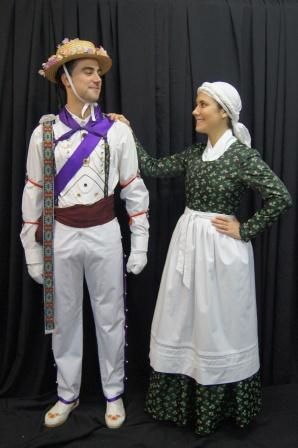

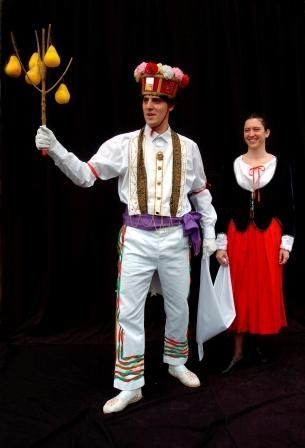




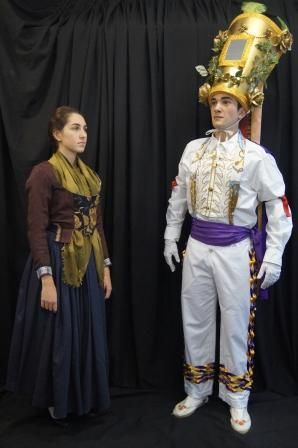
Different traditional costumes of Euskal Herria [x]
#euskal herria#basque country#pays basque#pais vasco#euskadi#culture#tradition#folklore#traditional costumes#clothing#traditional clothing#basque people
37 notes
·
View notes
Text
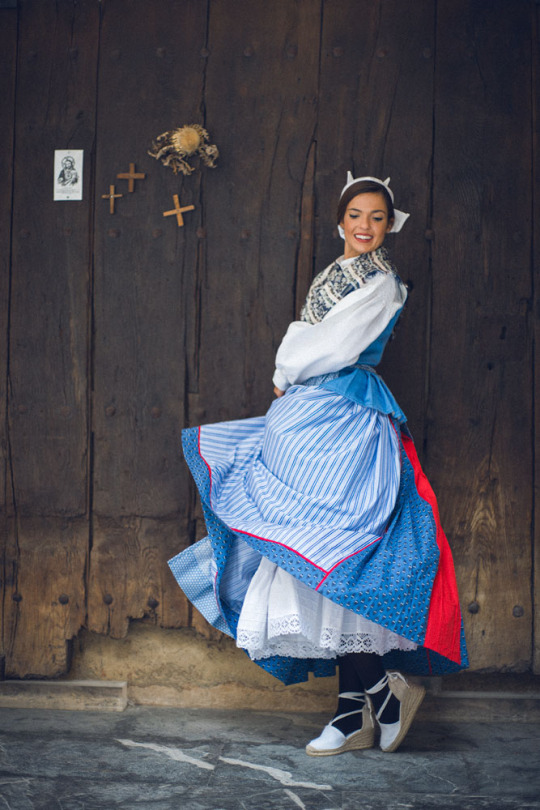
Basque woman, Spain, by Meltxora
#basque#spain#europe#western europe#folk clothing#traditional clothing#tradition#culture#folk#geography#people#traditional fashion#cultural clothing
213 notes
·
View notes
Text
I finally saw the movie “Iceman” about Otzi the Iceman. (I don’t know how to make an umlaut on this keyboard. Sorry.)
I need to rant a little about something. It’s the issue of trying to enjoy movies while being a history buff of that particular period. I know, right? You get it.
It’s the way that Mesolithic through Chalcolithic Europeans are generally portrayed. UGH UGH ME CALLED GLOGG, ME CAVEMAN. You get it. They’re always made to look more “primitive” than they probably even were.
I want to see more music. I want to see dancing (you actually have stuff to work with, a lot of European folk dance is attributed to the Neolithic). I want to see festivals. Life wasn’t ALWAYS nasty and brutish and short, and ancient people actually had cultures and societies.
I think there would have been a *lot* more color and a *lot* more symbolic imagery (paint on surfaces, carving, etc). There would have been a lot more ornament. We DO see people in woven clothing and wearing jewelry, but I just would expect to see some more color!
I REALLY wish that worldbuilders drawing on “stone age” Europe would actually consult with indigenous people, because if my Coast Salish ancestors can look FINE AS FUCK using lithic industry, then there’s no excuse for Mesolithic and Neolithic Europeans to look... well... gross.
All of the grooming implements that have been found, the beads, the standing looms, all of the symbolic imagery that’s been found, the intact weaving and embroidery traditions (Amazigh, Anatolian, Eastern European, Basque) that have deep Neolithic origins, the fact that dyes existed then, the hints from statuary that they may have either worn body paint or practicing tattooing... all of this speaks to the ancients not looking scraggly or unkempt, or running around in unsewn skins.
(I can buy that Otzi himself may have looked really rough, it’s been remarked on how isolated he was from populations of people like him, so who knows this man’s story, really. It’s all of the other people in that story.)
To give you some idea of what was “off” for me about this: Otzi himself lived between 3400-3100 BCE. This is LATE Neolithic, even Chalcolithic. He was contemporary to European cultures that were part of massive trade networks and built monumental architecture, such as Iberian and Maltese and Irish and several Aegean cultures. In fact, it’s contemporary to the Early Dynastic Period of Egypt - the first Pharaohs. And the whole ancient world was interconnected in ways we can’t even imagine. Ancients traded like WHOA. So they probably knew about each other.
Also, this always gets left out of the picture. And there may be political problems with portraying any of this now (I’m sure somebody will assume cultural appropriation). But there were cultural affinities between Europeans of that era, and cultures in the Middle East and North Africa. There are intact traditions that go back to the Neolithic, and could be used to reconstruct what the Neolithic world *might* have looked like, at least enough for a movie. Turkish kilim rugs have common links to European Neolithic symbolism, and probably techniques. So does a lot of Amazigh material culture. But even within Europe: many folk dances are from that origin.
It’s not like people have absolutely nothing to work with.
10 notes
·
View notes
Video
blue basque
A basque is an item of women's clothing. The term, of French origin, originally referred to types of bodice or jacket with long tails, and in later usage a long corset, characterized by a close, contoured fit and extending past the waistline over the hips. It is so called because the original French fashion for long women's jackets was adopted from Basque traditional dress. In contemporary usage it refers only to a long item of lingerie, in effect a brassiere that continues down, stopping around the waist or the top of the hips, the lower part essentially decorative rather than providing support or indeed warmth.
86 notes
·
View notes
Text
Argia [Cissamione One Shot]
[Done for the holiday exchange back at the Cissamione Server]
Argi, -a: Light in Basque
The clock ticked as the night outside the apartment kept on growing, throwing bony fingers against the windows from where Hermione kept on glancing at the, mostly, empty road. The muggle-based Christmas lights casted tinted shadows against the nighttime breeze and the laughter of those delighted for the first and timid snow that had fallen sometime that previous afternoon could be heard seeping from under the buzzing lampposts.
20 minutes since nightfall, the warmth coming from the hanukkiah felt more like a curse brought by a memory rather than what it stood out for and the brunette witch bit down on her bottom lip as she kept looking at the street outside, one hand raised towards the collar of her jumper, fingers worrying the clothing, twisting it only to ease the wrinkles she herself created short of a few seconds afterward in a continuous pattern.
She had wanted to wait, had hoped it wouldn’t be necessary but as the sun began its descent, the yule log already lighted on the small chimney they had managed to magic in a month ago after fulfilling the appropriate documentation for such thing, she had known she would be forced to mutter the prayers alone as she lighted each candle with the precision she had been taught. And, while she had expected it, feared it, it still made her eyes stung as she sighed deeply, trying to wait for her parents’ car even if she knew the longer she waited the less probable would be for them to appear.
“You are steaming.”
Narcissa’s gentle voice brought her back to the present, the older witch arms circling her waist and pressing her back against her front as she let her chin rest against Hermione’s shoulder. There was a second, a blast of perilous pride, in where the brunette wanted to move away from the embrace but, ultimately, she let herself sink into it as warm long fingers crawled up her chest only to circle her own, easing the constricting grasp she had on her collar until they fell lax against the blonde’s. Feeling the tickle of Narcissa’s hair against her cheek, the brunette angled her face slightly so she could still keep an eye on the road slightly below them, the sense of magic on their touch apparent in the rivulets of electricity she felt cursing her veins the second she burrowed herself some more against the hug.
“They are late.”
She didn’t offer any further information: not like it was necessary since, after all, they had had a similar talk for a few days now as the night her parents had promised to be there approached. Narcissa had been patient as Hermione worried herself, the first day of Hanukah passing in a blur as the brunette recited the three expected blessings over the candles, their flame jumping up to her fingers as her magic grew and surged afterward. She had received the call after she had sent the letter, afraid and nervous, and she had curled against Narcissa in a similar fashion she was now as her mother, slowly, so slowly, told her they would try to be there for the fourth night, her father’s voice at her side of the line harsh on his own doubt.
In a way, Hermione knew they were entitled to their stalling: she had been the one who had erased their very personalities in order to keep them safe, she had been the one who had taken a decision that had uprooted them all from the place she had grown up in, had returned less and less time again as everything around her magic world crumbled. Harry often spoke of how Hogwarts and the Burrow had been his home, had transformed into the places he felt he could be himself and while Hermione understood the implicit difficulties those words brought she often didn’t add to it nor mentioned the fact that, while she had loved Hogwarts and what the magic world brought to her, it had been a relief -shorter each year but warm altogether- to go back to a place in where conversations weren’t prefaced by an impending war in where they all seemed to have a stance to make. She had liked that, pretending to be a child, a girl, a teen, amongst her parents’ house and she had destroyed it with the aid of magic and the resolution of not seeing them perish under the hands of those she had failed to halt at first.
It had definitely transformed a difficult conversation into a harming one the second her parents had returned to her, memories restored and eyes sadder, darker, than she had ever imagined them having. And when the first year had passed and everything, she had was short, snippy conversations at the other end of a landline, she knew them lost to her.
And then Narcissa had come along with sapphire-like eyes and a keen sense on what meant to be family in a way she had never gotten to see by any other adult on her life. She hadn’t fallen in love with her because of that, but she had learned from her in the same way the blonde had learned to not use magic for absolute everything, of not relying on promises made by energy and hexes alone. And, most, importantly, the blonde, for a reason she was still trying to elucidate, had fallen in love with her too. Which was the reason why, when discussing Holiday traditions, on what were the ones the blonde wished to implement, Yule, fire, water cleansing being mentioned, Hermione had told her about hers and family as something not only chosen by decided.
Narcissa had been the one who had convinced her to send a letter to her mother; as nervous as she herself was and looked like whenever muggles were mentioned, the steep curve of someone who knew herself as complicit of so many wrongs during a war sometimes impossible to miss on the way she got out of breath as she spoke. And, while Hermione herself felt magic and muggle blood prickle in nervous admission, she had sent the letter and hoped.
And waited. Like she was doing now. 25 minutes after the nightfall, almost half an hour after the candles had been light, almost too close for them to die for the night, dim and grey-like the more she thought about them, about how she had been the one lighting them.
The two of them had fallen silent as seconds ticked by: latkes getting cold in the adjacent room and while Hermione wanted to keep scouting through the darkness she let her eyes fall close for a second as she took into Narcissa’s perfume, the scent a reminder of what she had, what she had gained, rather than what she had lost.
“Darling?”
The blonde’s voice echoed softly as she shook Hermione slightly, prompting her to open her eyes again; the darkness of the night being abruptly broken by a car that, slowly, moved towards their building as it tried to find a spot to park. Her parents’ car.
Nervous, Hermione glanced at the clock that presided the apartment’s entrance: not magical, merely muggle. 28 minutes since nightfall.
And, while it was late, she readied herself, extracting herself from Narcissa’s arms only to turn and kiss the older witch softly before shooting a grateful smile towards her, magic rising, twisting, dancing, on her fingertips.
“Thank you.”
She didn’t elaborate: she didn’t need to. It was going to be fine.
35 notes
·
View notes